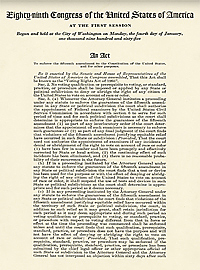| For Voting Rights, Don’t Keep Section 5 Alive |
 |
|
By Quin Hillyer
Wednesday, May 23 2012 |
In important court cases, it is the rarely the dissenting opinion that becomes a benchmark. In a case decided last Friday by the D.C. Circuit U.S. Court of Appeals, however, Judge Stephen Williams issued a tour de force of a dissent, explaining why the federal government should not (in effect) hold entire states guilty of racial discrimination without current proof thereof. If, on appeal, the Supreme Court adopts his analysis, it could undo vast amounts of mischief carried out under the pretense of protecting voting rights. The case involves Section 5 of the federal Voting Rights Act – a curious provision requiring most southern states, plus a scattering of counties or municipalities across the country, to secure “preclearance” – advance approval – from the Justice Department (or a three-judge court) before implementing any change in voting procedures. The goal is to block discrimination against the voting rights of blacks or other minorities. In practice, the application of Section 5 long ago sank into absurdities. Even the tiniest of changes, such as moving a polling location from a school cafeteria to the very same school’s gymnasium, requires the voting jurisdiction in question to seek preclearance. As with almost all bureaucratic processes, costs and annoyance factors may both be high. Worse, horror stories keep popping up about localities unable to print ballots on time, or unable to proceed with other election-related tasks, because the Justice Department failed to “pre-clear” some rudimentary alterations. Worst of all, Justice has sometimes used preclearance as a political cudgel, holding up decennial redistricting efforts or blocking ballot-integrity measures for purely partisan purposes. For example, even though the U.S. Supreme Court ruled 6-3 in a 2008 Indiana case (Crawford v. Marion County) that it is perfectly legitimate to require photo identification at polling places, the Obama Justice Department refused to pre-clear voter-ID laws in South Carolina and Texas. Those are practical arguments against Section 5, however, not constitutional ones. On the latter subject, the Supreme Court hinted fairly strongly in a 2009 case that because Section 5 “authorizes federal intrusion into sensitive areas of state and local policymaking,” in what would ordinarily violate the nation’s careful constitutional structure, Section 5 therefore could be found unconstitutional. In the end, though, the high court vacated the pre-clearance requirements on narrower grounds, statutory rather than constitutional, thus technically leaving the larger question unanswered. That larger constitutional question finally came squarely before the D.C. Circuit appeals court last week. Shelby County, Alabama is challenging Section 5, saying that by requiring only certain states and jurisdictions to seek pre-clearance of voting changes, the provision in effect unfairly treats those jurisdictions’ citizens as guilty until proven innocent. The selection of those jurisdictions, after all, was based on conditions in those places 47 years ago, and of course much has changed in racial attitudes and behavior since then. In order for such facially unequal treatment still to be allowable under the Constitution, the Supreme Court has previously ruled that Congress must act only in ways “congruent and proportional” to the harms the provision is attempting to forestall, and the action must be based on strong evidence of “conduct transgressing” constitutional provisions that protect against discrimination. Two of the three judges on the appeals court panel accepted Congress’ fact-finding on these matters as being adequate to meet those standards. The judges ruled against Shelby County, and in favor of Section 5, based on “deference to the considered judgment of the People’s elected representatives.” Judge Williams, however, blew away their reasoning. After all, Shelby County’s elected representatives are due no less deference than is Congress, absent strong evidence that Shelby’s officials or their constituents have transgressed. Section 5 is suspect, he wrote, because it “not only switches the burden of proof to the supplicant jurisdiction, but also applies substantive standards quite different from those governing the rest of the nation.” That explanation was mere warm-up, however, to Williams’ data-driven masterpiece of analysis. The original impetus for the Voting Rights Act, of course, was the obvious and overwhelming reality that black citizens in many places, especially the South, were being widely disenfranchised. Now, though, Judge Williams showed that the states and jurisdictions covered by Section 5 are no longer guilty of such sins. Williams showed that Mississippi, Georgia, Alabama, Texas, Louisiana and Arkansas now actually have higher ratios of black registration percentage to white registration percentage than the national average. The black voter-turnout rates in most “covered states” also more closely approximate the white turnout than does black turnout in non-covered states. In fact, in Alabama and Mississippi black turnout now exceeds white turnout. Likewise, the five states with the highest percentage of black elected officials, compared to black population, are all states burdened by Section 5. In other words, these statistics all show that Section 5 is counterproductively punishing the states that do the best, not the worst, to encourage black voter participation. Meanwhile, the perverse incentives of Section 5, especially as interpreted by Justice, have led to numerous situations in which, in the effort to aid the election of minority candidates, officials end up “concentrating minority voters in increasingly safe districts,” thus harmfully “isolating minority voters from the rest of the state.” In short, this is a soft and unintentional form of apartheid voting – something which obviously should be avoided, not encouraged. Section 5 has become disastrous. It must be overturned. |
Related Articles : |
























